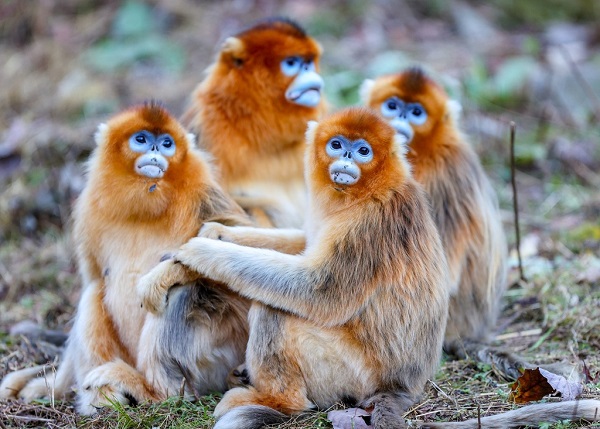Blog 3: Social System: Social Organization, Social Structure, Mating System, Care System
Blog 3: Social System: Social Organization, Social Structure, Mating System, Care System
Tirra Shawcroft
May 2, 2025
1. Social Organization:
De Brazza’s monkeys are highly social animals that tend to live in large groups of varying sizes. Troops of 10-35 members have been recorded living in different regions. They live in a dominant hierarchy, one-male, multi-female group known as a harem system, where there is one dominant male who has access to multiple females. In order to prevent competition and inbreeding, males will leave their troop when they reach sexual maturity, where they will go to find a troop of their own. This system leaves the young females with their natal groups, continuing to learn from the other females around them the skills for motherhood they need for their success.
2. Mating System:
Figure 1: A female De Brazza’s monkey grooms a male, Wikipedia.org, September 27, 2024
De Brazzas monkeys are sexually dimorphic in size, meaning that the males are primarily much larger than the females. Male De Brazza’s monkeys can reach up to 25 inches and weigh bout 15-17 pounds at full maturity. The females, on the other hand, only reach about 16 inches and average about 8 pounds at maturity, which is definitely a prominent size difference. The organization of these troops means that there will only be one male who has access to the troop's females. However, despite most De Brazza’s monkeys being primarily polygynous or polyandrous (males and females with multiple partners), there have been recordings of monogamous pairs as seen in figure 1. That being said, many sources claimed that mating patterns are dependent on their environment, the accessibility of females, and the troop size. Mating for De Brazza’s monkeys is seasonal; it is correlated with the blossoming of fruits during the months of February through March (New England Primate Conservation, 2021). The correlation between the mating season and the fruits coming into season is not just a coincidence, but is specific timing. Mating and the availability of fruit are very important as females need high amounts of food during gestation, and all individuals need as much energy as possible for the mating season. Males during this time become very protective of their females. Since one male is allowed access to all the female troops, a male has to be ready for any other males trying to sabotage his genetic success. Females, on the other hand, will lure males in for copulation by presenting themselves and putting on a “pout” face by pushing their bottom lip outward without opening their mouth, showing they are ready. Some females will use paternity confusion as a way to ensure their infant's success by mating with multiple males, none of whom know exactly who the father is.
3. Care System:
Figure 2: Baby De Brazza’s monkey and mother, Wikipedia.org, September 27, 2024
De Brazza’s monkeys have a primarily maternal care system, which is not uncommon in the primate world. After the birth of the baby, the mother carries her baby with her for about a year, creating a close relationship with her infant. For the first year, the baby is tucked under the belly as seen in Figure 2. Mothers remain with their babies, nursing them and acting as the primary caregiver until they are weaned onto solid foods, where the baby gains some independence. Despite the minimal information collected on the male's role in paternity, it's assumed they contribute to the overall protection of the troop and infants. The role of adult males and fathers is less defined, but it is presumed that they act as group protectors. Despite being polygynous (one male with multiple females), there was no infanticide recorded in this species. (New England Primate Conservation, 2021). Both parents invest a lot of time and energy into procreating. During the mating season, the dominant male will be protective of the females (or females if they are a monogamous pair), and the protectiveness continues throughout the infant's life to ensure his genetic success. Females also spend a lot of energy caring for the infant; taking care of the baby comes with many costs. The mother has to ensure she is getting enough food to care for herself and her baby until it is able to forage for itself. Then once the baby has some independence, it will take the entire juvenile period learning skills and lifestyles from the mother and surrounding troop mates. (Animal Diversity Web, 2025)
Resources
“DeBrazza’s Monkey, Cercopithecus Neglectus | New England Primate Conservancy.” New England Primate Conservancy, 17 Nov. 2021, https://neprimateconservancy.org/debrazzas-monkey/.
Myers, P., R. Espinosa, C. S. Parr, T. Jones, G. S. Hammond, and T. A. Dewey. The Animal Diversity Web. 2025, https://animaldiversity.org.
Wikimedia Foundation. (2024, September 27). De Brazza’s monkey. Wikipedia. https://en.wikipedia.org/wiki/De_Brazza%27s_monkey



Comments
Post a Comment